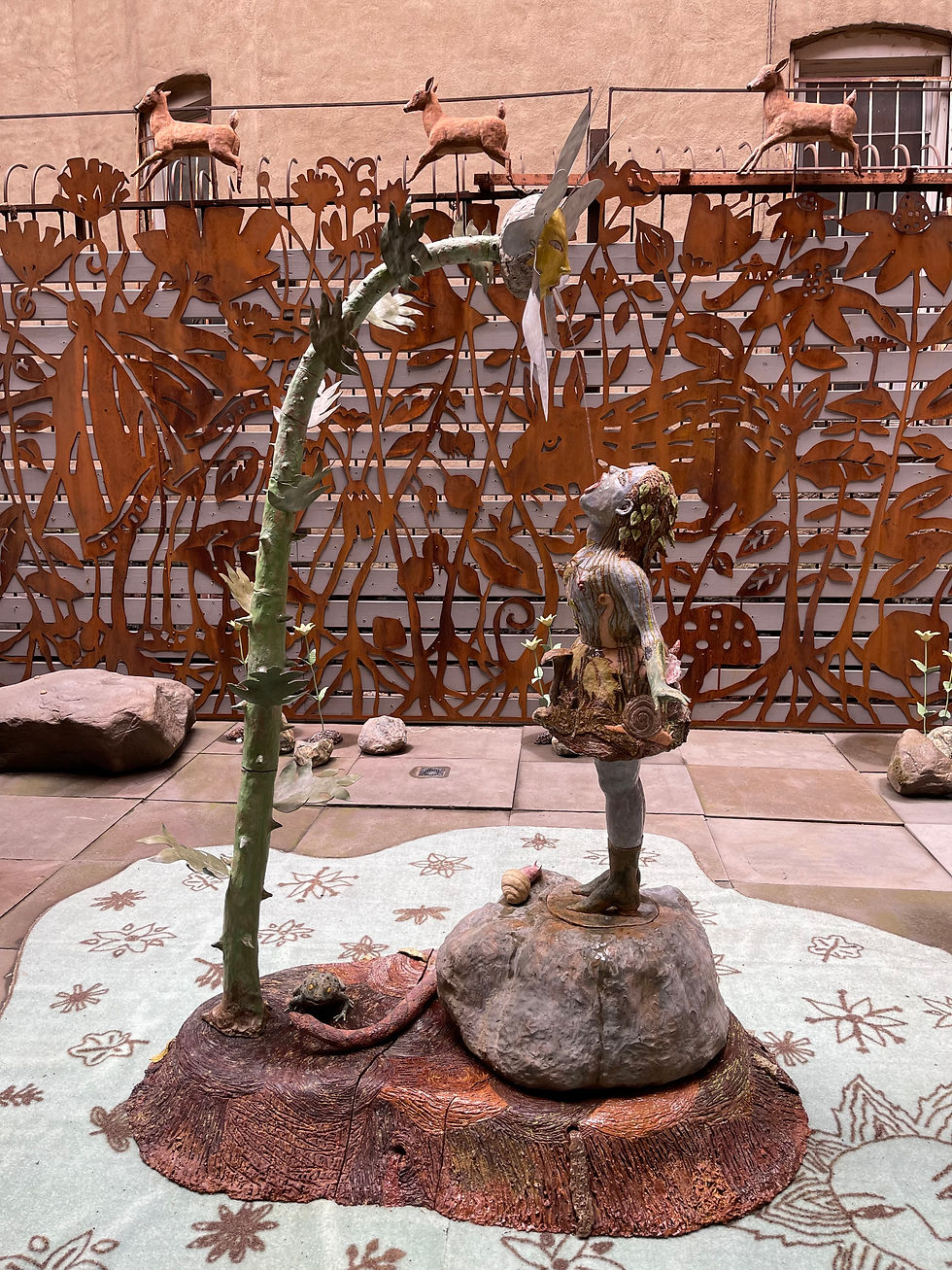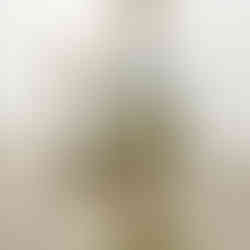Happy Earth Day!
- frida@artyardbklyn.org

- Apr 22, 2022
- 6 min read
Updated: Apr 25, 2022
We are thrilled to announce that BWAC invited ART YARD BKLYN to include our work in their spring exhibition! You can find our work on display in the café in the back of the second floor, which we use as our studio for in-person ART YARD sessions. Please join us for the opening reception Saturday April 30th from 1-6pm.

I installed the exhibition with ART YARD Artists Alison Guinet and Vera Tineo on Tuesday. I fear ART YARD Advanced Studio in-person working with Teaching Artist Ed Rath had to listen to my tap-tap-tap-bang-tap of installation while they worked.

Ed summarizes the session: “We opened this week’s lesson with a short discussion of the work of American painter Burgoyne Diller. A disciple of Piet Mondrian, Diller used vertical and horizontal elements to organize the picture plane into rectangular shapes of primary colors, black gray, and white. In a 1961 notebook, Diller diagrams how these simple elements generated three distinct themes in his work. Like Mondrian, Diller saw the vertical and horizontal as elements of movement and constant opposition.




Next, we looked at several oil paintings by Hans Hoffman, and reviewed his Push/Pull color theory.
Hans Hoffman, Memoria in Aeternum, 1962; Sanctum Sanctorum, 1962; Combinable Wall I and II, 1961; Morning Mist,1958; August Light, 1957.
The crux of Hoffman’s thirty plus years of teaching can be summed up as follows:
The painter has to take into account three things:
1. Nature and its laws;
2. The medium and its inherent qualities;
3. The artist’s psychological, spiritual, intuitive, and imaginative feeling.
We then set to work to emulate the ideas in Hoffman’s work, contrasting sharp edged cut paper with soft edge water color to create the Push-Pull effects found in Hoffman’s oil paintings.





At critique we discussed how knowledge passed on by master artists like Hans Hoffman continues to shape the work of subsequent generations, including our own.”
This week in ART YARD Advanced Studio on Zoom Teaching Artist Jane Teaching Artist Jane Huntington presented a wonderful session titled Rirkrit Tiravanija: Art & the Revolutionary Act of Sharing Food.

The class started with showing several slides of Rirkrit Tiravanija and his work in exhibitions where he cooks traditional Thai food– pad thai and green curry, and moved on to other installations that brought into the discussion protests between the red and yellow shirts in his native Thailand for “Who’s afraid of Red, Green, and Yellow?” (a nod to Barnett Newman’s “Who’s afraid of Red, Yellow, and Blue?) where in addition to giving visitors curry, he had art students draw a mural in charcoal based on photos of the protest. Then I showed other series of interactive work: the tea house and bamboo maze, his ping pong tables, and work from “do we dream under the same sky”.

Eloquently Zeke expresses his thoughts about the lesson: "I thought having food and games at an exhibit was interesting because at first it seems a little silly to show something as common and simple as making food or playing a game. But, I think putting something like that in an exhibit puts it in an isolated state where we can look at it more closely without any other noise, and see what really makes these communal practices tick."

Jane explains: “We discussed the power of sharing something personal with the community at large, and the healing aspect of interacting with others. The assignment was to do a piece on what you would like to share with others–it didn’t have to be food–and it could be in whatever medium you wanted, including 3-D.
For the 1st 24 minutes of our hour work time I showed a video on Rirkrit and his work.
The students created stunning and deeply personal pieces. Meridith did a water color based on the story of stone soup, Alison created a paper lasagna.


Maraya did a couple of water color postcards based on her grandmother’s apron’s pocket.
Maraya Lopez, Revolutionary Act of Sharing Food
Fatima’s depicted an intricate hairdo sprouting into indigenous African food staples. Fatima shared with the group the practice of hiding seeds in hair to secretly carry food and ultimately the endurance of edible culture.

Karla working on recycled photo album page in white ink created. a drawing about seed sharing.

Zeke made a paper hockey rink that you play with coins.

Marilyn a watercolor of her Seder. Depicting the table top as a single huge piece of matzoh!

Jane referenced important family food tradition with her grandmother’s delicious orange cake recipe collaged onto her own photograph of night trees in Prospect Park.

Assata did a watercolor of her favorite food – ramen!

Vera tells the story of the plantinos, a vital crop in the Dominican Republic.
Vera Tineo, Revolutionary Act of Sharing Food
The experience of teaching this lesson blew me away -- the stories that each of these pieces told–deeply felt and personal, were rooted in history and generosity.”
Karla adds: “Jane’s lesson was a great exercise drawing from a more performance/experiential based artist and creating individual interpretations of shared experience. Great variety of materials both two- and three-dimensional!”
This week ART YARD Teaching Artist Sarah Gumgumji joined me as a guest teaching artist for my class Making & Seeing Art in NY at Wagner College. I am excited to share the mixed media painted collages created in this session!
Sarah summarizes the day: “The students understood the concept of using different materials and color swatches of prints and patterns to offer a contemporary twist on representations of their own culture or community stories.
After looking at artwork by Oscar Howe, Mounir Fatmi, Bisa Butler, Wangechi Mutu, and Sarah's work (in that order below) , students made mixed media artworks composed of different media and materials using watercolor, collage, and embroidery to create mixed media art.
The artwork varies from 3D work using collage in different ways to the straightforward use of collage and painting, but both tell a story of their own community or culture. Meridith’s Makers & Seers did a great job using watercolor with collage materials; they exceeded my expectation and did fantastic artwork.”


Isabella Anton, Dillon Burke, Julianna Bevilacqua, Lance DeSorbo, Alison Guinet, Agathe Yabit, Brianna Tormenia, and Christopher Field.

Managing Director Dennis Buonagura writes: “I found many comparisons to Nayarit Tineo's Advanced Studio lesson last week honoring Mother Earth, called "Gaia: Personifying The Earth '' while viewing the Kathy Ruttenberg exhibit Sunshine At Midnight at the Lyles and King Gallery on Catherine Street in Manhattan.
The show has an overall feminine theme - many pieces looking like fairytale creatures and nymphs, with menacing rodents, dead birds, or anthropomorphic forest animals and magical plants/trees. Some are carrying life inside of them, some are giving and supporting life in a variety of ways (although seemingly unnatural), others appear to be taking life away. Are they dreams or nightmares? Maybe a new way to look at Mother Nature's process .... or anger? A take on our attachments to mothers or nature via different types of umbilical cords? Rites of Spring? Paganism? This is only one person's opinion - I guess we'd have to ask Kathy Ruttenberg what they're all about.

A couple are very large in scale while some are small ceramic and wood reliefs. While most refer to life, a few have implications of death and decay.
Kathy Ruttenberg, A Little Birdie Told Me, 2014 (installation views) photo by Dennis Buonagura
Lyles and King is a great space - it connects from Catherine Street through to Henry Street and has a small courtyard between them, which holds a fountain and a pair of iron gates amongst little rabbits, birds, and leaves. All looking perfectly at home in an outside setting.

Wondering what art to go see this weekend?
You can visit ART YARD Artist Maraya Lopez during DUMBO Open Studios April 23 - April 24, 2022, 12PM- 6PM. Maraya is located in suite #213 at 20 Jay Street, Dumbo, Brooklyn, NY.
Congratulations to ART YARD Teaching Artists Susan Hamburger and Richard Estrin who have work included in Covid Häus at Mother-In Law's experimental art space in Germantown, New York.
We are pleased to announce that, thanks to the hard work of ART YARD Teaching Artist Maraya Lopez, ART YARD BKLYN now has a Facebook page and Professional Instagram profile!

Please help build our networks by asking your FB friends to 'Follow" us and connect with us on IG! Facebook: https://www.facebook.com/ARTYARDBKLYN, Instagram: artyardbklyn.
Speaking of my Makers & Seers at Wagner College, ART YARD Teaching Artist Vera Tineo is currently working on animating the charcoal drawings the students created in the sessions in which she was guest teaching artist. Here is a perfect Earth Day sneak peek of the project!
Drawings by Maurane Dubois, animated by Vera Tineo.
I planted some seeds from Karla to celebrate Earth Day! What are you planning?
🌱🌱🌱





















































Comments